 W
WThe swastika symbol, 卐 or 卍, is an ancient religious icon in the cultures of Eurasia. It is used as a symbol of divinity and spirituality in Indian religions, including Hinduism, Buddhism and Jainism.
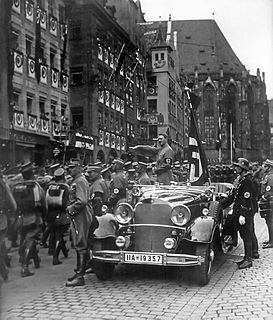 W
WThe Blutfahne, or Blood Flag, is a Nazi Party swastika flag that was carried during the attempted coup d’etat Beer Hall Putsch in Munich, Germany on 9 November 1923, during which it became soaked in the blood of one of the SA men who died. It subsequently became one of the most revered objects of the NSDAP. It was used in ceremonies in which new flags for party organizations were consecrated by the Blood Flag when touched by it.
 W
WThe Camunian rose is the name given to a particular symbol represented among the rock carvings of Camonica Valley. It consists of a meandering closed line that winds around nine cup marks. It is engraved in the form symmetrical, asymmetrical or swastika.
 W
WThe dragon's head and wind chime is an elaborate type of gilt bronze Korean wind chime and Korean dragon sculpture of later Silla / early Goryeo art, probably serving as a roof end tile figure on a Korean Buddhist temple or Korean palace. There are two similar near-complete examples, at the Metropolitan Museum of Art in New York City, and at Leeum, Samsung Museum of Art in Seoul, which is designated National Treasure No. 781.
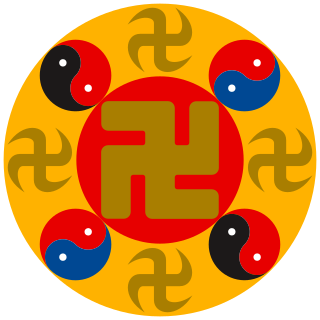 W
WThe Falun (法輪) symbol pictured is used as an emblem by the Falun Gong spiritual group. The term translates literally as "law wheel." Other representations of the Falun are utilized in other Buddhist traditions. In Buddhism, the Dharmachakra represents the completeness of the doctrine. To "turn the wheel of dharma" means to preach the Buddhist doctrine, and is the title of Falun Gong's main text.
 W
WThe Fernie Swastikas were a women's hockey team that was formed in 1922 in Fernie, British Columbia. Their uniform used as a symbol the swastika, which before World War II was a common religious symbol, and especially a sun sign. In 1923, the Swastikas won the Alpine Cup at the Banff Winter Carnival women's ice hockey championship. There were two other teams called the Swastikas, one in Edmonton, Alberta, and another the Windsor Swastikas of Windsor, Nova Scotia.
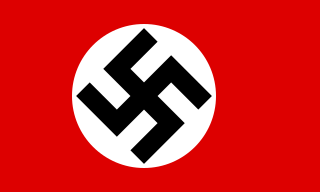 W
WThe flag of Nazi Germany, officially the flag of the German Reich, featured a red background with a swastika on a white disc. This flag came into use initially as the banner of the Nazi Party (NSDAP) after its foundation. Following the appointment of Adolf Hitler as Chancellor in 1933, this flag was adopted as one of the nation's dual national flags, the other being the black-white-red horizontal tricolor of the German Empire.
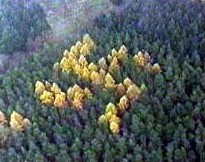 W
WThe forest swastika was a patch of larch trees covering 0.36 ha area of pine forest near Zernikow, Uckermark district, Brandenburg, in northeastern Germany, arranged with their light colors to look like a swastika.
 W
WFylfot or fylfot cross (FILL-fot), is an English symbol equivalent to the sauwastika, or left-facing swastika. It is a cross with perpendicular extensions, usually at 90° or close angles, radiating in the same direction. Its right-facing variant is referred to as a gammadion. According to some modern texts on heraldry, the fylfot is upright and typically with truncated limbs, as shown in the figure at right.
 W
WThe swastika design is known from artefacts of various cultures since the Neolithic, and it recurs with some frequency on artefacts dated to the Germanic Iron Age, i.e. the Migration period to Viking Age period in Scandinavia, including the Vendel era in Sweden, attested from as early as the 3rd century in Elder Futhark inscriptions and as late as the 9th century on Viking Age image stones.
 W
WThe flag of Jainism has five colours: red, yellow, white, green and black. These five colours represent the Pañca-Parameṣṭhi. It also represents the five main vows, which are small as well as great.
 W
WThe lauburu is a traditional celtic hooked cross with four comma-shaped heads, resembling a swastika. Today, Lauburu is a symbol of the Basque Country and the unity of the Basque people. It is also associated with Celtic peoples, most notably Galicians and Asturians. It can be constructed with a compass and straightedge, beginning with the formation of a square template; each head can be drawn from a neighboring vertex of this template with two compass settings, with one radius half the length of the other.
 W
WThe Swastika Laundry was an Irish business founded in 1912, located on Shelbourne Road, Ballsbridge, a district of Dublin. Due to its name and logo being associated with the Nazi Party in Germany, the name was changed in 1939 but their logo endured.
 W
WThe 20th-century German Nazi Party made extensive use of graphic symbols, especially the swastika, notably in the form of the swastika flag, which became the co-national flag of Nazi Germany in 1933, and the sole national flag in 1935. A very similar flag had represented the Party beginning in 1920.
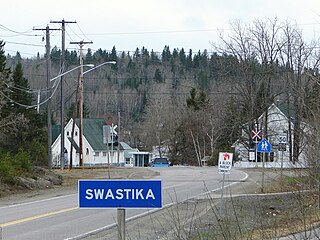 W
WSwastika is a small community founded around a mine site in Northern Ontario, Canada in 1908. Today it is within the municipal boundaries of Kirkland Lake, Ontario. It has frequently been noted on lists of unusual place names.
 W
WThe Red Swastika Society is a voluntary association founded in China in 1922 by Qian Nengxun (錢能訓), Du Bingyin (杜秉寅) and Li Jiabai (李佳白). Together with the organisation's president Li JianChiu (李建秋), they set up their establishment of the federation in Beijing as the philanthropic branch of the Chinese salvationist religion Guiyidao (皈依道), the "Way of the Return to the One".
 W
WThe Snoldelev Stone, listed as DR 248 in the Rundata catalog, is a 9th-century runestone that was originally located at Snoldelev, Ramsø, Denmark.
 W
WThe swastika curve is the name given by Martyn Cundy and A. P. Rollett in their book Mathematical Models to a type of quartic plane curve.
 W
WThe Swastika Stone is a stone adorned with a design that resembles a swastika, located on the Woodhouse Crag on the northern edge of Ilkley Moor in West Yorkshire, England. The design has a double outline with four curved arms and an attached S-shape, each enclosing a so-called 'cup' mark, the like of which can be found on other stones nearby.
 W
WThor's Fight with the Giants is an 1872 painting by the Swedish artist Mårten Eskil Winge. It depicts the Norse god Thor in a battle against the jötnar. The thunder god rides his chariot pulled by the goats Tanngrisnir and Tanngnjóstr, wears his belt Megingjörð, and swings his hammer Mjölnir, which is wreathed in lightning. The painting was made using oil on canvas, has the dimensions 484 x 333 centimeters, and belongs to Nationalmuseum in Stockholm.
 W
WThe tursaansydän or tursan sydän, also called mursunsydän, is an ancient symbol used in Northern Europe. The symbol originates from prehistoric times. The tursaansydän was believed to bring good luck and protect from curses, and was used as a decorative motif on wooden furniture and buildings in Finland. During the 18th century the simple swastika became more popular in Finnish wood decoration than the more complex tursaansydän.
 W
WThe swastika is an ancient Eurasian religious symbol with the earliest known example found in Mezine, modern Ukraine, that generally takes the form of an equilateral cross with four legs each bent at 90 degrees in either right-facing (卐) form or its mirrored left-facing (卍) form. It is considered to be a sacred and auspicious symbol in Hinduism, Buddhism, and Jainism and dates back at least 11,000 years.
 W
WThe Windsor Swastikas were a Canadian ice hockey team in Windsor, Nova Scotia, from 1905–1916. Not to be confused with the Fernie Swastikas across the country in British Columbia, the Swastikas chose their name as at the time the swastika was a symbol associated with luck and success.